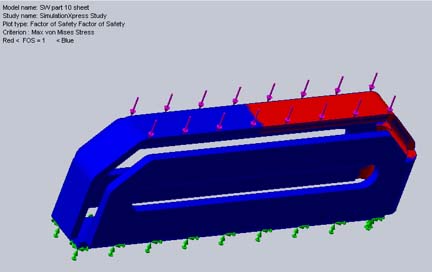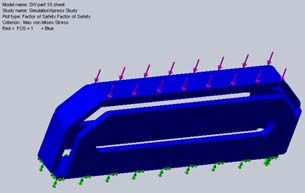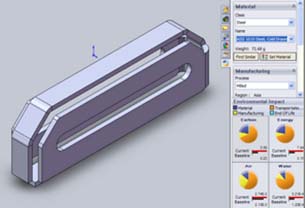Latest News
January 14, 2010
By Kenneth Wong
Rick Chin, SolidWorks’ director of product innovation, needs your help. He wants you to tell him what he should do next.
 Fig 1. Putting a 5 N load on a part made in low-density polyethylene shows severe pressure in one corner (simulation completed in SolidWorks 2010). |
Having completed his last project, the integration of Sustainability Xpress into SolidWorks, he’s now ready to tackle his next challenge—one that he hasn’t quite figured out yet. So (in a decision he may regret later) he’s turning to the user community for suggestions on what his next adventure should be. At SolidWorks blog, he posed the following questions:
- What are the important things you need to accomplish?
- What are the things getting in your way?
- What in your current design process contributes or takes away from your competitive edge?
- What makes collaboration with others effective or a total waste of your time?
 Fig 2. When the same part is made in cold drawn steel, it’s shown to be able to withstand the same load and pressure (simulation completed in SolidWorks 2010). |
My suggestion to him is not restricted to SolidWorks alone. It’s one that I would encourage all CAD developers to consider. Simply put, I’d like to see analysis, sustainability, and cost estimation in a single application window.
Analysis and Sustainability
To me, analysis and sustainability are like the Gemini twin. They’re closely related, but often in pursuit of competing agendas. When you run analysis, you are, for the most part, studying how and where a model will break. The two most common fixes to a weak model are:
- increasing material volume (for example, by making certain walls and surfaces thicker or by adding ribs) or
- switching to stronger material (for example, by replacing iron with steel).
By contrast, when you’re tackling sustainability issues, or trying to reduce the environmental impact of your product, you often resort to:
- shaving off material (to reduce the carbon footprint of your part by reducing its sheer size) or
- switching to less harmful materials (preferably to one that requires less energy to produce).
 Fig 3. But the switch from low-density polyethylene to steel also increases the environmental impact of the part. The red bars in the impact indicators show an increase in all areas (simulation completed in SolidWorks 2010). |
Therein lies the eco-conscious designer’s dilemma: Quite often, what you need to do to strengthen a part may raise the cost to the environment; and what you need to do to make your part less harmful to the environment may make it more likely to break under stress and pressure.
I’m not suggesting you should prioritize sustainability over product quality; nor am I suggesting you do the opposite. The wisest approach, in my view, is to strike a delicate balance, to design the strongest possible part using the least environmentally harmful materials and processes.
Currently, in most midrange and high-end mechanical design software (and even in a few low-end ones), you can do simple stress tests on a part. In SolidWorks 2010, in addition to analysis, you can also study the part’s environmental impact using the Sustainability Xpress module. This is a welcome, pioneering attempt at integrating green design into CAD.
Personally, I think the two functions—analysis and sustainability—go hand in hand and ought to be examined in the same application window. As the two are set up in SolidWorks 2010, you can access both functions under the Evaluate tab, but you must do these tests one at a time. Most likely, you’ll run analysis, then run sustainability test.
You might discover in an analysis session that switching from low density PE to cold-drawn steel makes your part perform better under pressure. But when you move into sustainability testing, you might discover that the same switch exponentially increases the carbon footprint of your part, possibly because of the fossil fuel required to produce and dispose the volume of steel needed. So you go back to analysis, then to sustainability test—and round and round you go.
Show Me the Money
I realize adding cost estimate to CAD—specifically, the cost of material and production—is tricky, but it’s worth exploring. The cost for wood, plastic, steel, and others vary from region to region. In addition, cost estimate is often handled in PLM (product lifecycle management) or ERP (enterprise resource management) software; CAD, developed primarily to create geometry, has never been ideally suited for cost.
Assume, for a moment, that unit cost of material acquisition by region (say, the average cost of reclaimed steel in North America) and production cost can be obtained from a certain industry-standard database. Then it should be put to good use in CAD design, along with analysis and sustainability. This would allow an engineer to automatically obtain the total cost of a part once he or she has specified the materials and production processes. This eliminates the time wasted in producing a design concept, only to discover later that it’s been rejected because of the high cost involved.
Usually, the purpose of cost analysis is to keep it as low as possible. Once again, this may prove incompatible with some of the choices you need to make to create a stronger part or a less hazardous design. Nevertheless, I feel cost should be part of the trilogy that makes up product design.
Cheaper, Safer, Stronger
Originally, this was to be my answer to Rick Chin’s blog post, but at 800+ words, I’m sure I’ve exceeded the space allotted for a blog comment. It’s now closer to an essay than a comment. So I share this with you, in the hope that some of you might have the know-how and wherewithal to somehow combine analysis, sustainability, and cost into a single application window.
Subscribe to our FREE magazine, FREE email newsletters or both!
Latest News
About the Author
Kenneth Wong is Digital Engineering’s resident blogger and senior editor. Email him at [email protected] or share your thoughts on this article at digitaleng.news/facebook.
Follow DE





